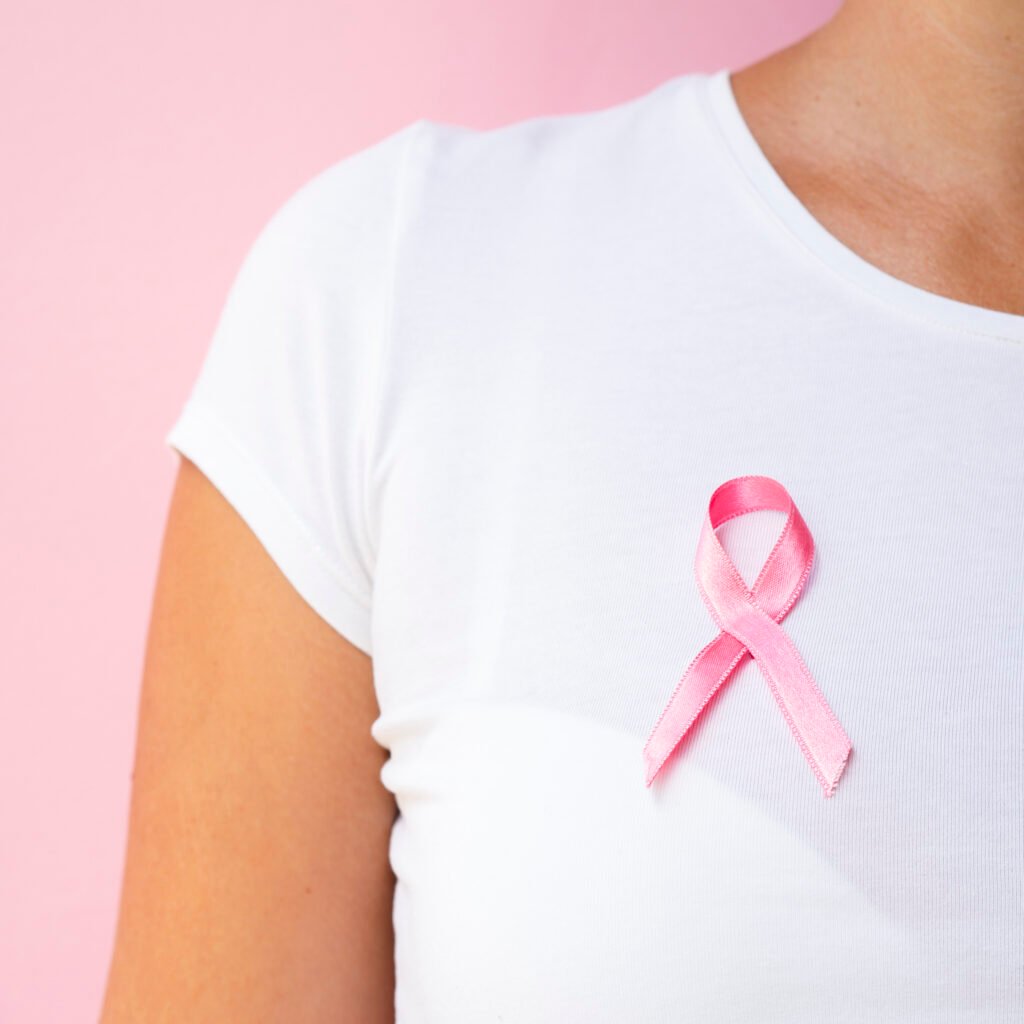Breast Cancer
- Home
- »
- Cancer Info
- »
- Breast Cancer

Cancer Treatment
Breast Cancer
Breast cancer is the most common form of cancer in women worldwide and the vital cause of cancer-related death among women.
Symptoms of Breast Cancer:
- Lump: Appearance of painless lumps in the breast, which was not present earlier.
- Sudden change in breast symmetry, fullness or abnormal shrinkage of the breast.
- Presence of blood in nipple discharge and sudden retraction or inversion of the nipple.
- Skin changes: ulceration and dotted appearance on the skin similar to an orange peel.
- Armpit (axilla) - Fullness and presence of lumps

Causes of Breast Cancer:
The breast is a hormone-responsive organ. Most of the causes are related to changes in estrogen and progesterone hormone levels in the body.
- Non-modifiable: causes which cannot be changed
- Gender: Womenare at higher risk of acquiring breast cancer and 1% chance of risk in men
- Age:Chances of contracting breast cancer increase with age
- Family history: Only 5-10% of breast cancer is inherited. These cancers are related to sudden changes (mutation) in genes controlling normal cell functioning in our body. BRCA 1 and BRCA 2 are the most common genes associated with breast cancer, the presence of other genes also increases the chance of acquiring breast cancer but with less mutation frequency.
- Estrogen exposure: Early menarche (getting first menses at an early age) and delayed menopause (the time when menses stops) exposes females to estrogen for a prolonged period.
- Dense breast:The breast texture varies in people; having dense breasts and patients with a personal history of breast cancer have an increased risk of contracting cancer.
- Breast lesions: Some pre-cancerous breast diseases like atypical hyperplasia or lobular carcinoma in sit increases the risk of breast cancer
- Radiation exposure: The breast tissues, when exposed to radiation while undergoing therapies for cancer at a young age, can cause breast cancer in future. Although with new radiation therapy technologies radiation exposure can be restricted.
Prevention of Breast Cancer
- Lifestyle modification: Adopting good lifestyle practices like healthy food choices, adequate physical activity and avoiding excess alcohol, etc., is crucial to bypass breast cancer.
- Screening: Healthy individuals should undergo screenings periodically to detect any abnormality or cancer in the early stages. Screening is a preliminary investigation usually performed by trained medical professionals.
- Self-breast examination: A breast self-exam is a systematic approach women who have reached 20 years of age can perform to examine their breasts periodically or once a month. It can be challenging to diagnose the presence of cancer with this approach, but it is good practice to get to know your body and promptly take action in the event of noticing any changes.
- Clinical breast examination: This is a routine examination of the breast by experts, which can be started as early as 30 years and can be taken up semi-annually or annually.
Imaging
- Mammogram: In simpler terms, it is an X-ray of the breasts used to detect small breast lumps, abnormal calcification, and architectural distortion at the early stages. There are different guidelines for screening and can be done only on women who have reached 40 to 50 years of age.
- Breast MRI: For high-risk women with strong family history and upon confirming genetic mutation MRI is performed to rule out the presence of breast cancer.
What if a breast lump is detected
Not all breast lumps are cancerous, and their presence should be examined and evaluated by specialists to ascertain their type.
Clinical examination by experts
Imaging: Ultrasound is performed on both breasts for women under 40 years of age and a mammogram is done after the age of forty. A mammogram is performed on younger women when there is uncertainty surrounding the malignancy.
Biopsy: Biopsy is a clinical procedure wherein a small tissue is taken from the lump to confirm its nature. It is a painless procedure, and local anaesthesia is administered to the patient if required to avoid discomfort.

Management of Breast Cancer
Once the presence of cancer is confirmed, the step is to determine the stage of cancer. Depending on the clinical investigation chest X-ray, CT scan chest, Ultrasound – abdomen or PETCT scan is recommended to determine the stage of cancer.
Breast cancer requires a multimodality treatment approach, and cancer staging is crucial in deciding and scheduling therapies which are a combination following:
- Surgery: It can be done first or after chemotherapy. Surgery is basically directed to remove lumps and adjacent lymph nodes in the axilla. It can be of different types.
- Mastectomy: Modified radical mastectomy is the removal of the full breast with axillary lymph nodes.
- Breast conservation surgery (BCS): Removal of cancerous lumps along with axillary lymph node dissection. BCS is always combined with radiation therapy in order to avoid recurrence.
- Plastic reconstruction: A multitude of options are available to reconstruct the breast to enhance cosmesis, which includes rotation of tissue, using muscle and skin from nearby areas known as pedicle flap, or can be done as free flap also.
- Chemotherapy - Drugs to treat cancer cells are injected into the body, these drugs have tolerable side effects, and the side effects have been minimized with new forms of chemotherapy drugs with the evolving changes in medical and treatment approaches. Chemotherapy is crucial to contain the cancer cells circulating in the blood.
- Radiation therapy: Intense energy usually X-rays or proton radiation is aimed directly at the operated area to kill cancer cells to minimize recurrence.
- Hormone therapy: Since breast cancer is hormone-driven it's crucial to assess the hormone receptor status. Depending on the presence or absence of hormones hormone therapy is offered at the end of the treatment process.
- Targeted therapy: Similar to hormone receptors, determining the presence of HER2 Neu is essential to plan treatment approaches. Addressing the presence of HER2 Neu with suitable treatments helps to derive the best outcomes.
Testimonial
Feedback From Our Happy Patients














